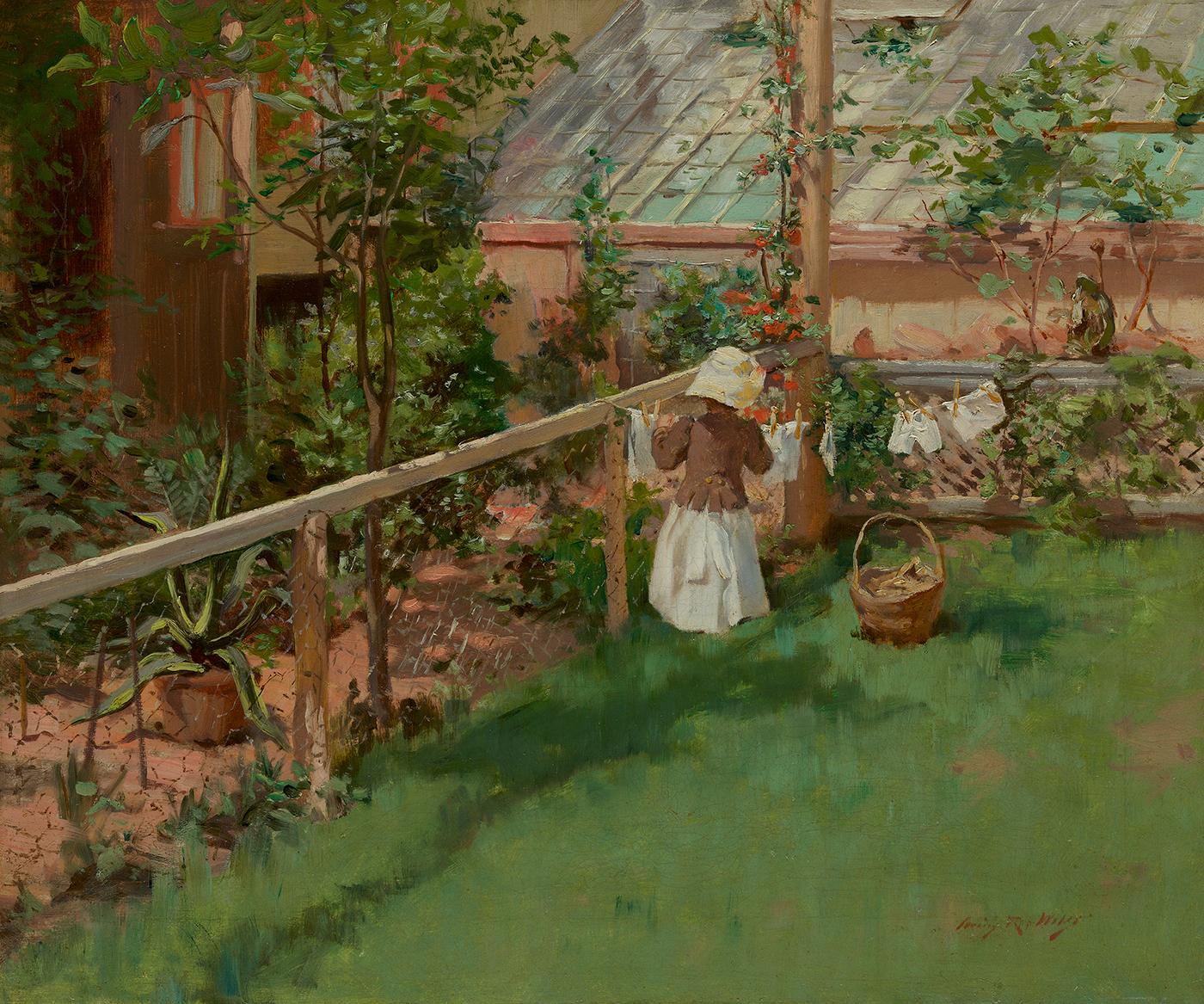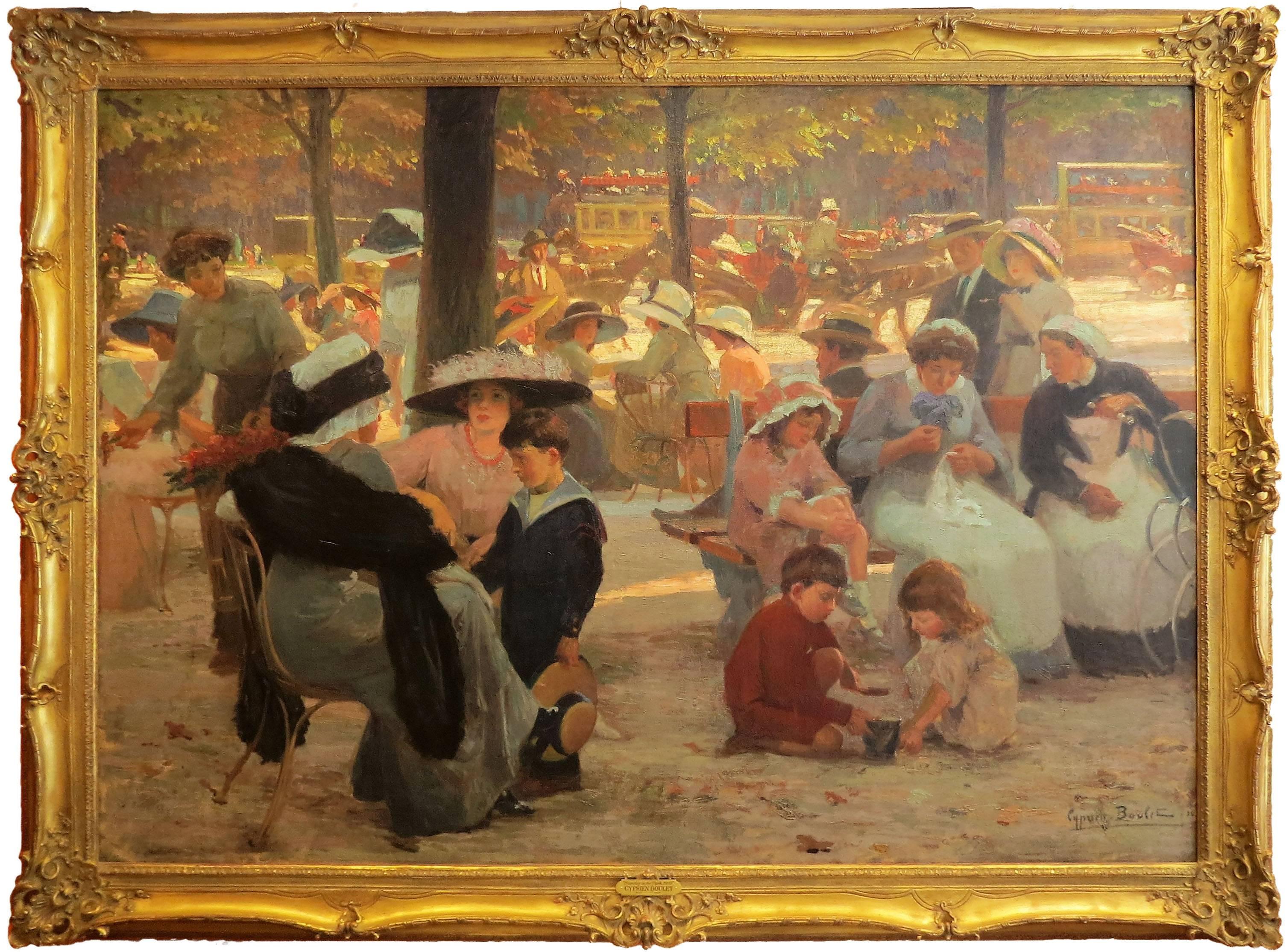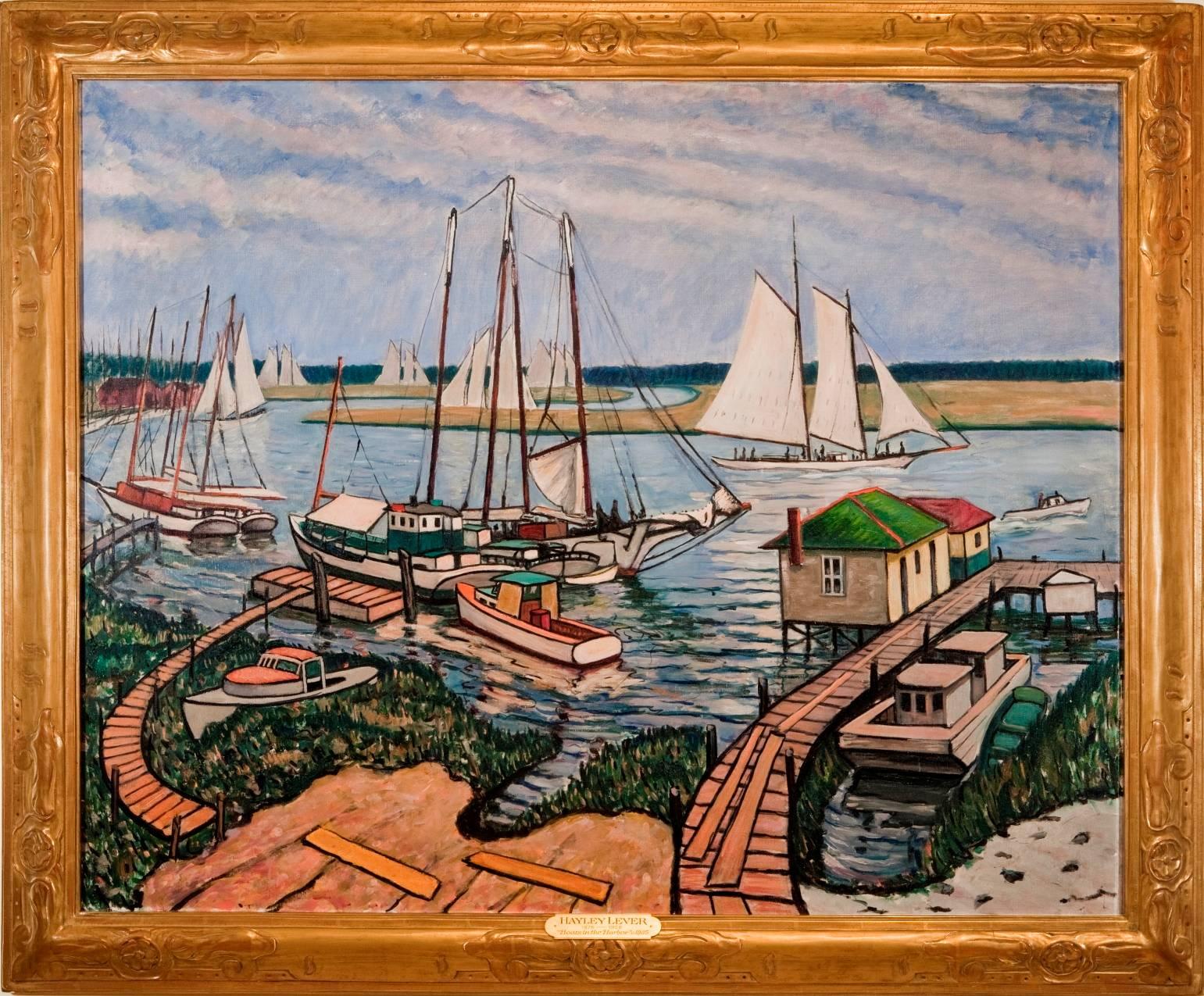Paul SchumannNavy or Coast Guard 1930s Pursuit Boat Galveston Texas Artist Texas CoastCirca 1930s
Circa 1930s
About the Item
- Creator:Paul Schumann (1876 - 1946)
- Creation Year:Circa 1930s
- Dimensions:Height: 14 in (35.56 cm)Width: 16 in (40.64 cm)Depth: 2 in (5.08 cm)
- More Editions & Sizes:Image Size 9 x 12Price: $9,500
- Medium:
- Movement & Style:
- Period:
- Condition:Please visit our 1stdibs storefront for additional goodies.
- Gallery Location:San Antonio, TX
- Reference Number:1stDibs: LU76935123501
Paul Schumann
Paul R. Schumann was a Texas impressionist seascape painter, who has been called the Gulf Coast counterpart of Winslow Homer. He was born in Reichersdorf, in the German State of Saxony, in 1876, one of four children of Albert F. Schumann and Mina Clara Zincke. Only he and his brother, Albert Otto, survived infancy. The family emigrated to the United States, in 1879 and settled in Galveston, Texas, where he lived until his death. Schumann evinced an early interest in art and received encouragement from the superintendent of the Galveston Public Schools. He studied painting with local painter, Julius Stockfleth, before turning to plein air painting. He married Carolina Adela Bergmann from Fredericksburg, Texas, in 1903 and later credited her as his inspiration. They had three children, Paul August, Clara Adela and Robert Edward. Carolina died in 1937. He painted many paintings in and around Fredericksburg, as well as New Mexico. Schumann started out as a portrait and landscape painter, but became best known for his later seascapes and harbor scenes. Writers have speculated that his preference for marine subjects was influenced by a childhood experience of falling into the mill race, at his father's sawmill or by his cross-ocean journey, at the age of three. One critic wrote that he catches with unfailing dexterity, the kinship of the sea with the sky and the land,the storm clouds, the pouty, sulky thunderheads or the washed sky, after an April shower.
Schumann built model ships, for use as models for his seascapes, which sometimes featured boats and ships, ranging from fishing vessels to three-masted schooners. During the 1910s, he traveled extensively around the United States, painting in New Mexico, Arizona, Colorado, California, Illinois and along the southeastern Atlantic Coast. His favorite site remained the Texas Gulf Coast, for its tropical colors and changeable skyscapes and he became known as a leading interpreter of typical Texas skies, as well as the deeper blues of the South Atlantic and the quiet waters of the Pacific Coast.
Schumann belonged to a number of art associations, including the Art Association of New Orleans, Galveston Art League, Society of Independent Artists, Society of Texas Artists, Southern States Art League and Texas Fine Arts Association. Schumann exhibited his work frequently and over the course of his career, won many exhibition awards, prizes and medals. His work is held in the collections of a number of museums and institutions, including the Rosenberg Library (Galveston, Texas), Fort Worth Art Museum (Texas), the Panhandle-Plains Historical Museum (Texas) and Southwest Texas State University. He died of pancreatic cancer, in 1946.
Schumann began as a realist and evolved into an impressionist, likewise, moving from brush to palette knife as his primary tool. Of his painting, The Storm, he noted that he began with a brush and later used his fingers. His heavy impasto has been likened to that of Wayne Thiebaud. His palette relied heavily on the primary colors and he worked mainly in oils, but also made watercolor, pen-and-ink and crayola studies. He frequently worked outdoors, becoming a familiar figure to local fishermen, who would sometimes shift their boats around to help out his compositions. In part, because of an impressionist technique that did not allow for a great deal of overpainting, Schumann was a prolific artist, who could turn out up to three canvases a day. He is credited with some 1500 paintings, in 25 years and was able to support his family by his painting and private teaching, even during the Depression years.
As a teacher, Schumann was said to require his students to make drawings for five years, before he would allow them to work with color. Critics have praised Schumann for the atmospheric intensity and vigor of his seascapes. One critic wrote that in American art, Mr. Schumann probably has no peer at capturing in oil dancing waters or a sailing ship on a glassy sea. The San Antonio Express admired his clearness of colors, the warm tones of the afternoon reflected sunlight and lovely transparency in the wet beach sand, all aglow from the reflections of the June skies and their billowy sunlit clouds. A French critic termed his work bold, direct and free and called Schumann himself a poet of exquisite sensibility. An American critic concluded that Schumann was doing for the Texas Gulf shores what Winslow Homer did for the Coast of Maine, arguing that if he had been painting along the New England Coast instead of the Gulf of Mexico, his marines would have been known all over the world.
- ShippingRetrieving quote...Ships From: San Antonio, TX
- Return PolicyThis item cannot be returned.
- " Summer Evening Southwest Texas " 1909 Texas Hill CountryBy Julian OnderdonkLocated in San Antonio, TXJulian Onderdonk "Summer Evening S. W. Texas" Texas Hill Country (1882 - 1922) San Antonio Artist Image Size: 9 x 12 Frame Size: 15 x 18 Medium: Oil on panel Dated 1909 "Summer Evening S. W. Texas" "A Texas Painter Worked Under the Radar in New York," By Eve M. Kahn, March 6, 2014, The New York Times Onderdonk, a San Antonio native who died of an intestinal ailment in 1922, at 40, is best known for painting swaths of Texas bluebonnets. Those canvases can bring more than $500,000 each, while his New York scenes usually end up in the five-figure range. Onderdonk’s parents were painters in San Antonio, and in 1901, when he was a teenager, they sent him to New York for training. Through 1909, he lived in various Manhattan apartments and Staten Island houses. He then returned to Texas, but continued to spend months at a time in New York. In 1902 he had married a Manhattan teenage neighbor, Gertrude Shipman. While she focused on raising their daughter, Adrienne, and worrying about their strained finances, “he created more than 600 works of art, often producing a painting or two a day,” Eyewitnesses recorded his prolific pace in New York, but Onderdonk works bearing those dates rarely turn up. The puzzling gap in his productivity is explained in family correspondence that the Bakers uncovered: The artist admits that he was signing pieces with pseudonyms. He mostly used Chas. Turner and Chase Turner and occasionally resorted to Elbert H. Turner and Roberto Vasquez. Julian Onderdonk was the son of the important Texas landscapist, Robert Onderdonk. He was the father's pupil at age 16. Sponsored by a Texas patron, he studied at the Art Students League in New York when he was 19, the pupil of Kenyon Cox, Frank DuMond, and Robert Henri. He also studied with William Merritt Chase on Long Island. In 1902, having lost his Texas patron because he married, he asked $18 for 12 paintings at a Fifth Avenue dealer in New...Category
Early 1900s Impressionist Landscape Paintings
MaterialsOil
- "IN THE LAND OF THE SPANISH OAK " TEXAS HILL COUNTRY DATED 1910By Julian OnderdonkLocated in San Antonio, TXJulian Onderdonk (1882 - 1922) San Antonio Artist Image Size: 20 x 30 Frame Size: 29 x 39 Medium: Oil Dated 1910 "In The Land Of The Spanish Oak" Spectacular larger scene by Julian...Category
1910s Impressionist Landscape Paintings
MaterialsOil
- "Brackenridge Park" San Antonio Texas.By Jose ArpaLocated in San Antonio, TXJose Arpa (1858-1952) San Antonio Artist Image Size: 18 x 24 Frame Size: 21 x 27 Medium: Oil Circa 1920s "Brackenridge Park" San Antonio Texas. Biography Jose Arpa (1858-1952) Born in Carmona, Spain, José Arpa y Perea was known as "The Colorist Painter" of figures and landscapes, especially in Texas where he brought a fresh approach to San Antonio painting in his bright, sunlit local scenes. He was also an etcher, illustrator, and muralist as well as an art teacher, and he started and ended his career in Spain. His subjects include the Grand Canyon of Arizona. Please visit our 1stdibs storefront to view more of our fabulous goodies. He began his art study as the pupil of Eduardo Cano de la Pena at the Academy of Fine Arts in Seville and then spent six years in Rome followed by extensive travel through Africa and Europe. His reputation was solid enough that the Spanish government sent four of his paintings as part of the exhibition to the 1893 World's Columbian Exposition in Chicago. In 1894, as an illustrator, he accompanied a Spanish army expedition to Morocco where the Spanish had been defeated by Rifi tribesmen. In the mid-1890s, he was brought to Mexico City, reportedly by a special Mexican naval vessel, to head the Academy of Fine Arts, but declined the position once he understood the responsibilities. Instead he joined one of his Spanish schoolmates and went to his home in Puebla, Mexico, where his use of bright colors earned him the name of "Sunshine Man." He became close to the children of this man, and in 1903, accompanied them as a guardian to school in San Antonio. After twenty years of traveling in Spain, Mexico, the Southwest, and South America, Arpa settled in 1923 in San Antonio, Texas, where he became Director of the San Antonio Art School and painted bright, sun-filled landscapes. He taught landscape and portrait painting and was exceedingly prolific, and several San Antonio collectors accumulated large numbers of his works. Among his close artist friends were Robert and Julian Onderdonk, Tom and Joe Brown, and Charles Simmang. They were members of a San Antonio group who painted together and called themselves the "Brass Mug...Category
1920s Impressionist Landscape Paintings
MaterialsOil
- "STAGING ON THE SOUTHERN ARIZONA TRAIL" STAGECOACH ARIZONA / CALIFORNIABy Marjorie ReedLocated in San Antonio, TXMarjorie Reed a.k.a. Harvey Day (1915-1996) California, Arizona Artist Image Size: 16 X 20 Frame Size: 22 X 26 Medium: Oil on Canvas "Valley of the Monuments"Category
20th Century Impressionist Landscape Paintings
MaterialsOil
- "CAREFREE" WESTERN, COWBOYS, HORSES, CATTLE, PRICKLY PEAR CACTUS (1921-1990)By James BorenLocated in San Antonio, TXJames Boren (1921 - 1990) Waxahatchie, Texas / Oklahoma Artist / Member Cowboy Artists of America Image Size: 28 x 42 Frame Size: 40 x 53 Medium: Oil "Ca...Category
1970s Impressionist Landscape Paintings
MaterialsOil
- "APRIL" TEXAS HILL COUNTRY BLUEBONNETS IMAGE: 25 X 30 FRAME: 33 X 38 CIRCA 1940SLocated in San Antonio, TXRobert Wood (G. Day) (1889 -1979) San Antonio Artist Image Size: 25 x 30 Frame Size: 33 x 38 Medium: Oil "April" Texas Hill Country Bluebonnets Biography Robert Wood (G. Day) (1889 -1979) A painter of realistic landscapes reflecting a vanishing wilderness in America, Robert Wood (not to be confused with Robert E. Wood) is reportedly one of the most mass-produced artists in the United States. His painting became so popular he was unable to meet all of the demands, and many of his works were reproduced in lithographs and mass distributed as prints, place mats, and wall murals by companies including Sears, Roebuck. He was born in Sandgate, Kent on the south coast of England near Dover, the son of W.L. Wood, a famous home and church painter who recognized and supported his son's talent. In fact, he forced his son to paint by keeping him inside to paint rather than playing with his friends. At age 12, Wood entered the South Kensington School of Art. As a youth, he came to the United States in 1910, having served in the Royal Army, and he never returned to England. He traveled extensively all over the United States, especially in the West, often in freight cars, and also painted in Mexico and Canada. His itinerant existence took him to Illinois where he worked as a farmhand, to Pensacola, Florida where he married, briefly in Ohio, Seattle, Washington, and Portland, Oregon. In 1912, he was in Los Angeles, and in the late 1920s and early 1930s, in San Antonio, Texas, where he lived and in 1928 exhibited in the "Texas Wildflower Competition." From San Antonio, he gained a national reputation for his strong colored, dramatic paintings. Some of that prestige has been credited to his association with Jose Arpa, prominent Texas artist. Wood also gave art lessons, and one of his students was Porfirio Salinas. During this period, Wood sometimes signed his paintings G. Day or Trebor, which is Robert spelled backwards. In 1941 he went to California and painted numerous desert and mountain landscapes and coastal scenes. He lived in Carmel for seven years, and then moved to Woodstock, New York, but he soon returned to California, settling first in Laguna Beach, then San Diego, and finally in the High Sierras, where he and his wife built a home and studio near Bishop and lived until his death in 1979. Robert Wood was born March 4, 1889, in Sandgate, England, a small town on the Kentish coast not far from the white cliffs of Dover. His father, W. J. Wood, was a successful painter who recognized Robert's unusual talent. At the age of twelve, his father enrolled Wood in art school in the small town of Folkstone. He then attended the South Kensington School of Art. While attending art school, Wood won four first awards and three second awards, one each year, a record. In 1910 after service in the Royal Army, nineteen-year-old Wood and his friend, Claude Waters, immigrated to America. Initially, he settled in Illinois and worked as a hired hand on a farm belonging to Water's uncle. He would then strike out on his own, living the life of an itinerant painter. Wood traveled as a hobo, hopping freight trains and selling or bartering small paintings to support him along the way. When times were hard, he worked at whatever job was available. In this manner, he saw most of the United States and fell in love with rural America. By 1912, Wood visited Los Angeles for the first time, arriving on the day of the Titanic tragedy. Later that year, he had met, courted and married young Eyssel Del Wagoner in Florida. The couple moved to Ohio where a daughter, Florence, was born. During World War I, the family moved to Seattle where a son, John Robert Wood, was born in 1919. In the early 1920's, the young Wood family was almost constantly on the move. They stayed for short periods in Kansas, Missouri, California and for a longer time in Portland, Oregon, where Wood's friend Claude Waters had settled. Wood's seemingly endless wanderings disrupted his family life and delayed his development as a painter. However, through his travels he developed an appreciation for the American landscape that would inspire him for the rest of his career. Although aware of the current movement away from traditional realism in American art, he elected to travel that solitary path and remain true to his own vision of American’s grandeur and beauty poetically translated through his landscape and seascape paintings. In 1923, the Wood family discovered the beautiful city of San Antonio, Texas and it was there that he and his family would finally settle. He studied briefly at the San Antonio Art School with Spanish colorist Jose Arpa y Perea (1860-1952), who had arrived in San Antonio that same year. In the latter part of the 1920’s, Jose Arpa’s influence quickly became evident. Wood after several years of experimentation was becoming fine easel painter, capable of great subtlety with a new mature original style. Like Texas painters Robert Onderdonk (1853-1917) and his son Julian Onderdonk (1882-1922), Robert Wood concentrated on the distinctive Texas landscape with its Red Oak trees and wildflowers that covered the hill country landscape. He developed a reputation for his scenes of Blue Bluebonnets, the state flower. In the spring, the Texas prairie is covered with wildflowers, especially in the hill country surrounding San Antonio and Austin. Wood incorporated native stone barns and rough wood farmhouses that added authenticity and romance to his compositions. In 1925, Wood was divorced from his wife. In 1932, he moved to the famous scenic loop on San Antonio's outskirts. While still living in Texas, he took extensive western sketching...Category
1940s Impressionist Landscape Paintings
MaterialsOil
- 'Agay, le château et le Sémaphore'. Oil on canvas. Signed.By Armand GuillauminLocated in Paris, FR'Agay, le château et le Sémaphore'. Oil on canvas. +/- 1922 Signed lower right Measurements : 60 x 73 cm. This painting will be recorded in the second volume of the Catalogue Raisonn...Category
1920s Impressionist Landscape Paintings
MaterialsOil
- Union Square, Winter (Washington Monument)By Theodore RobinsonLocated in New York, NYAs one of the first, and most important, American Impressionists, Theodore Robinson helped to introduce the French style to American artists and audiences.Category
19th Century American Impressionist Landscape Paintings
MaterialsOil
- At the ClotheslineBy Irving Ramsey WilesLocated in New York, NYSigned lower right: Irving R. WilesCategory
Late 19th Century American Impressionist Landscape Paintings
MaterialsCanvas, Oil
- Miner Hillard Milling CompanyBy George William SotterLocated in New York, NYSigned lower right: G.W. Sotter; on verso: MINER HILLARD / MILLING Co.Category
Mid-20th Century American Impressionist Landscape Paintings
MaterialsOil, Board
- "Sunday in the Park, 1910"By Cyprien Eugène BouletLocated in Lambertville, NJSigned Lower Right Cyprien-Eugène Boulet (1877 - 1927)Category
Early 20th Century Impressionist Landscape Paintings
MaterialsCanvas, Oil
- "Boats in the Harbor"By Hayley LeverLocated in Lambertville, NJOriginal Period Frame Hayley Lever (1876 - 1958) Hayley Lever's exceptional career path took him from the shores of his native Australia to those of England, and then the United S...Category
1930s Impressionist Landscape Paintings
MaterialsCanvas, Oil





